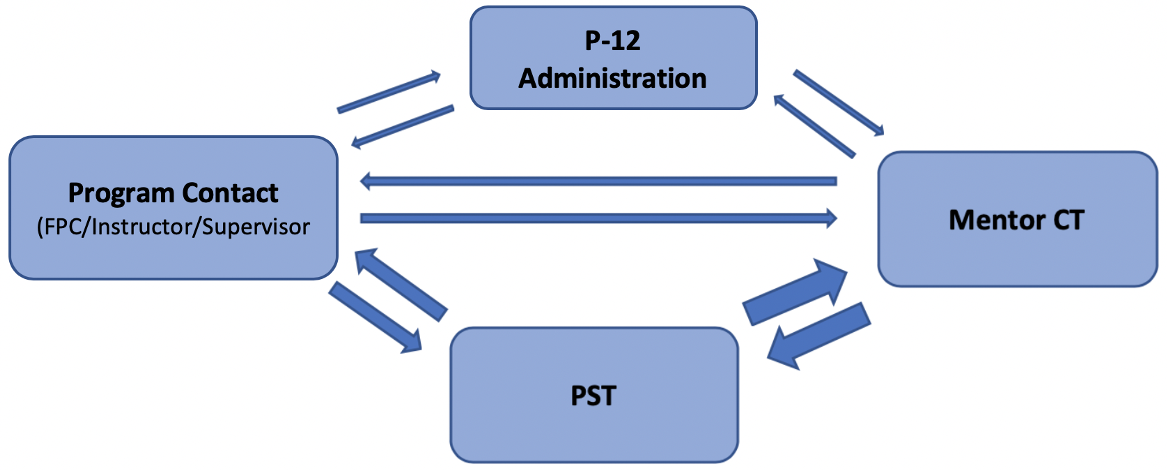Module 6: Systems of Communication and Professional Behaviors
Pathways of Communication
To maximize the quality of the experience for all participants, note that the directionality of the arrows communicates the pathways of communication, while the thickness of the arrows is more of a reflection of the frequency of communication between those particular participants.

Fostering effective systems of communication – Examples in Practice
Fostering effective communication can take varied forms, but some common goals and recommended approaches are helpful for everyone to consider.
Experienced Mentor CTs confirm the importance of clear, direct, repeated, and respectful communication as evidenced in the following comments:
“Either prior to the placement or the first day [this can be in person, email, or even a phone conversation], I ask what they expect from the placement and what is required from them, and then I add any necessary information that I feel was left out.” – T. Matthews, Mentor CT, Middle School
“[I like to] sit them down and have a talk where you get to know them and then tell them what you expect. The direct approach works best. [You] need to be friendly and have a sense of humor.” – V. Lilley, Mentor CT, High School
“I meet with them on their first day and go over expectations and revisit periodically throughout the placement. Expectations include punctuality in attendance, dress, confidentiality, student relations, etc.” – D. Mathias, Mentor CT, Elementary
Clear expectations communicated at the very beginning of the early field experience is the best approach for limiting confusion or subsequent points of conflict. For PSTs who have had few or no previous field experiences, reminders and clarification about expectations are helpful!. A growth mindset models that learning is a process and we learn from mistakes. Sharing that even the Mentor CT makes mistakes can help the PST assume a less defensive response when the mentor CT needs to draw their attention to a particular concern. It is critical to have a conversation about any concern before it mushrooms into something more challenging to resolve.
“Usually, if you are upfront with the PST, things resolve themselves.” M. Bair, Mentor CT, Elementary
“I have not had many issues that talking with the PST doesn’t resolve.” P. Dolan, Mentor CT, Elementary
Methods of Communication
Face-to-face communication:
The best method of communicating is in person. It reduces misunderstandings and allows for timely questions. Relationship building, discussion of expectations, observation conferencing and feedback, and critical conversations about cultural competence are all best served when the Mentor CT and PST can find a time to meet face-to-face.
Electronic communication:
Face-to-face conversations are not always possible. This is especially true regarding communication between the program contact and the Mentor CT, but applies to all participants in the field experience. Using school-affiliated email communication is also a very effective way to share information. (Please avoid the use of private email addresses.) Consider ways to reduce questionable ‘tone’ by being personable, avoiding extreme adjectives (e.g. extremely, really, deeply) or negative wording, and describe what can be done, rather than what can’t be done. Always re-read an email before hitting send.
Cellphone communication:
The Mentor CT can decide whether or not they are comfortable sharing their cell phone number with the PST. Texting is becoming the new normal for quick conversations. This can be especially helpful if a change prompted by illness or weather conditions might impact the attendance of either person on a particular day. If phone numbers are not shared, it is even more critical that each person involved is checking their emails daily and responding appropriately!
